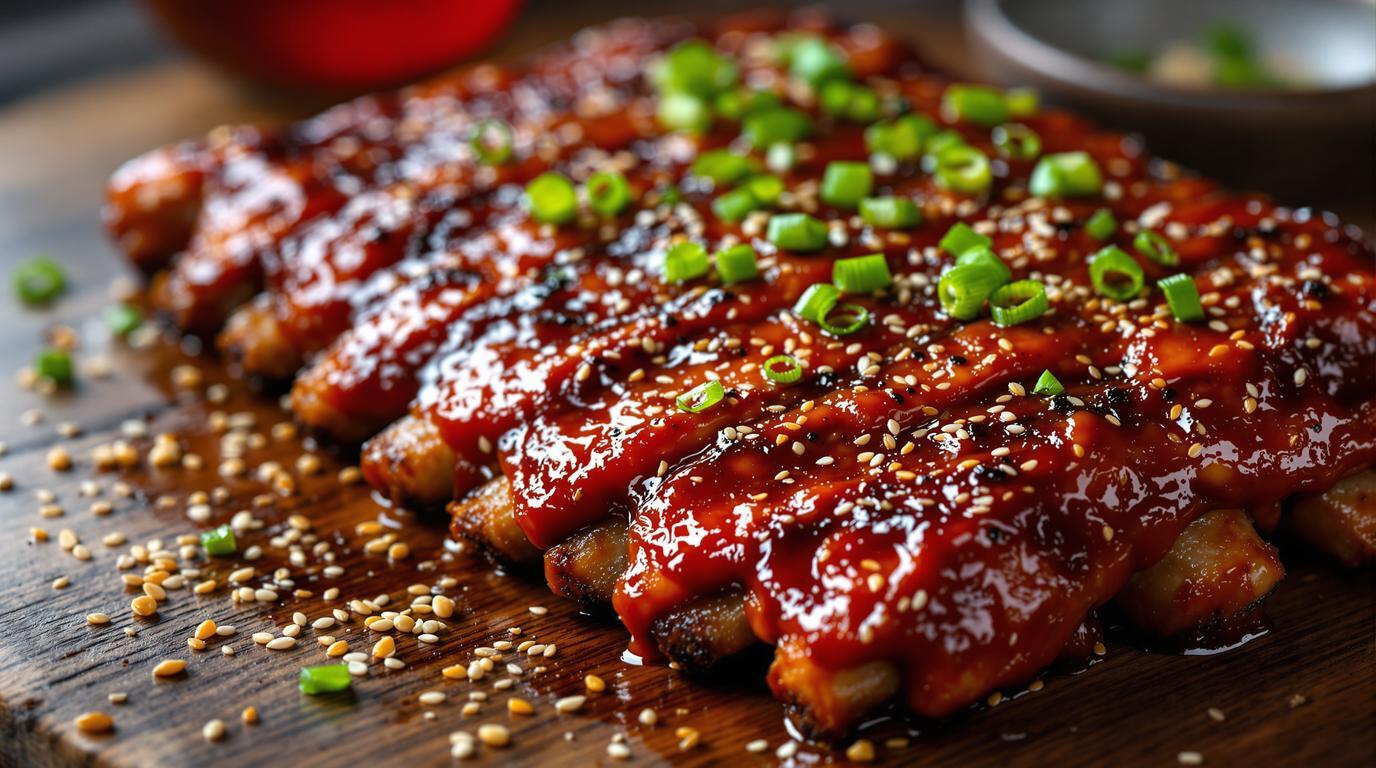There’s something almost magical about the way Korean gochujang transforms ordinary pork ribs into something extraordinary. I’ll never forget the first time I visited Seoul’s Gwangjang Market, where the scent of sizzling meats and fermented chili paste filled the air. That experience forever changed how I approach fusion cuisine – respecting tradition while embracing new possibilities. These Asian Fusion BBQ Ribs bridge cultures, combining the slow-cooked tenderness of American barbecue with the bold, complex flavors of Korean cuisine.
The Sweet-Spicy Symphony of Gochujang Ribs
The heart of this dish is gochujang – Korea’s beloved fermented chili paste that delivers a perfect balance of sweet, spicy, and umami flavors. Unlike the straightforward heat of many Western hot sauces, gochujang offers layers of complexity from its fermentation process that dates back centuries.
“In traditional Korean homes, gochujang was made in earthenware pots and fermented outdoors,” my Korean colleague Chef Min once explained to me. “The slow fermentation process creates that distinctive depth that simply can’t be rushed.”
While authentic Korean barbecue typically features thinly sliced meats, I’ve adapted this recipe to embrace Western-style ribs, creating a fusion that honors both culinary traditions. The long marination time allows the flavors to penetrate deeply, while slow cooking ensures fall-off-the-bone tenderness.
Essential Ingredients & Preparation
For 4-6 servings, you’ll need:
- 2 racks pork baby back ribs (about 4-5 lbs/1.8-2.2 kg)
- ½ cup (130g) gochujang paste
- ¼ cup (60ml) soy sauce
- ¼ cup (50g) brown sugar
- 2 tablespoons rice vinegar
- 2 tablespoons sesame oil
- 6 garlic cloves, minced
- 2 tablespoons fresh ginger, grated
- 2 tablespoons honey (for glazing)
- Toasted sesame seeds and sliced green onions (for garnish)
The night before cooking, prepare your marinade. Can’t find gochujang? While not identical, you can substitute with 3 tablespoons sriracha mixed with 1 tablespoon miso paste and 1 teaspoon brown sugar – though I strongly recommend seeking out the real thing for authentic flavor.
Step-by-Step Instructions
1. Prepare the ribs: Remove the membrane from the underside of each rack by sliding a butter knife under the edge and pulling it away with a paper towel. This crucial step allows the marinade to penetrate the meat fully and prevents chewy texture.
2. Make the marinade: In a bowl, whisk together the gochujang, soy sauce, brown sugar, rice vinegar, sesame oil, garlic, and ginger until smooth. The mixture should have a thick, glossy consistency that will cling to the ribs.
3. Marinate: Place the ribs in a large, shallow dish or heavy-duty zip-top bag. Pour the marinade over, turning to coat completely. Cover and refrigerate for at least 8 hours, preferably 24 hours, turning occasionally.
4. Prepare for cooking: Remove ribs from refrigerator 30 minutes before cooking. Preheat your oven to 300°F (150°C) or prepare a grill for indirect cooking at medium-low heat.
5. Cook low and slow: For oven cooking, place ribs on a rack over a foil-lined baking sheet, meaty side up. Cover loosely with foil and bake for 2½ hours. For grilling, place ribs on the cooler side of the grill and cook covered for about 2-3 hours. In both methods, the meat should be tender but not falling apart.
Chef’s Note: The key to perfectly tender ribs is patience. When properly cooked, the meat should gently pull away from the bone with slight resistance – not fall off completely. This texture balance preserves the integrity of the meat while ensuring tenderness.
6. Glaze and finish: Mix honey with 1 tablespoon of the marinade (set aside before using on raw meat). Brush this glaze over the ribs and continue cooking uncovered for 15-20 minutes until caramelized but not burnt.
7. Rest and serve: Let ribs rest for 10 minutes before cutting between the bones. Garnish generously with toasted sesame seeds and sliced green onions.
Perfect Pairings and Presentation
These ribs deserve accompaniments that complement their sweet-spicy profile. I recommend serving them with traditional Korean sides like quick-pickled cucumbers or kimchi. For a refreshing contrast, try my Blackberry Basil Sparkling Water – its bright acidity cuts through the richness beautifully.
For dessert, consider ending with something light and fruit-forward like Char-Grilled Peaches or Pistachio Ice Cream Bars.
What I love most about these ribs is how they demonstrate food’s power to bridge cultures. Every time I serve them, whether at family gatherings or professional events, they spark conversation and connection. The complex flavors tell a story of tradition and innovation – reminding us that the best culinary experiences often happen at these delicious intersections. Now go fire up your oven or grill, and bring a taste of this Asian fusion magic to your own table!
